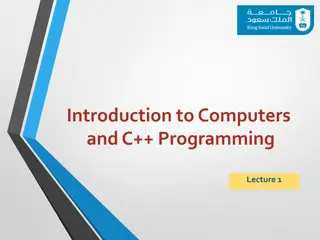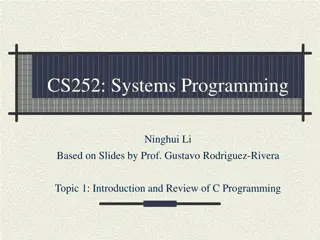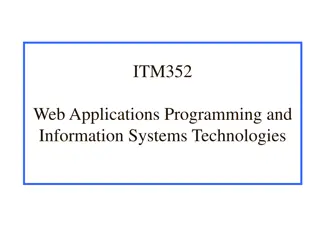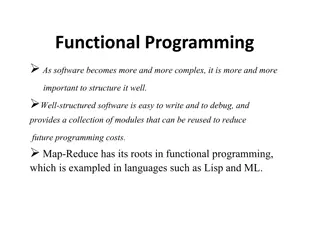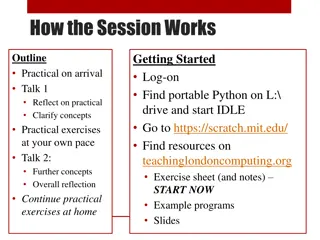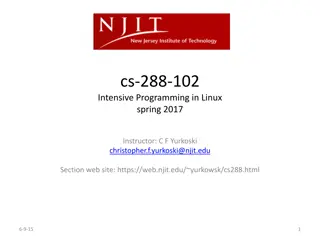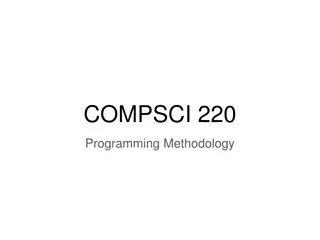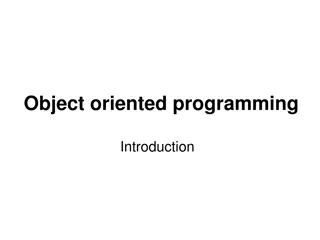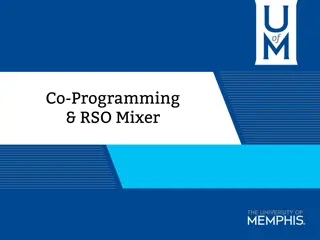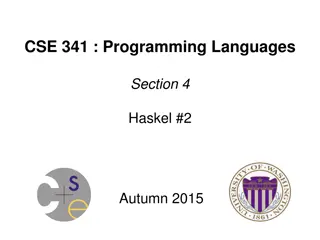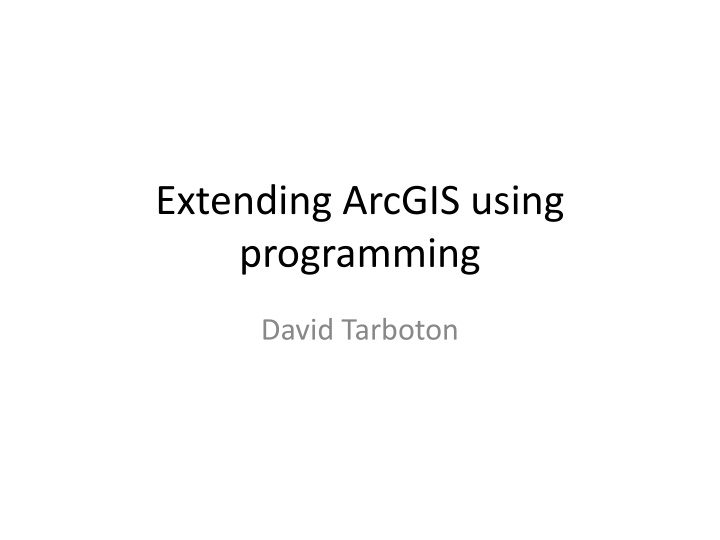
Extending ArcGIS with Programming for Geoprocessing Tasks
Learn how to enhance ArcGIS functionality by automating repetitive tasks, implementing new behavior, and utilizing Python environments. Explore the three views of GIS - Geodatabase, Geovisualization, and Geoprocessing. Discover ArcGIS programming options, Python environments integrated into ArcGIS Pro, and executing Python commands for each Geoprocessing tool. Dive into examples like watershed delineation using Python in ArcGIS.
Download Presentation

Please find below an Image/Link to download the presentation.
The content on the website is provided AS IS for your information and personal use only. It may not be sold, licensed, or shared on other websites without obtaining consent from the author. If you encounter any issues during the download, it is possible that the publisher has removed the file from their server.
You are allowed to download the files provided on this website for personal or commercial use, subject to the condition that they are used lawfully. All files are the property of their respective owners.
The content on the website is provided AS IS for your information and personal use only. It may not be sold, licensed, or shared on other websites without obtaining consent from the author.
E N D
Presentation Transcript
Extending ArcGIS using programming David Tarboton
Why Programming Automation of repetitive tasks (workflows) Implementation of functionality not available (programming new behavior) Steepest direction downslope Proportion flowing to neighboring grid cell 3 is 2/( 1+ 2) Proportion flowing to neighboring grid cell 4 is 1/( 1+ 2) 3 2 4 2 1 Flow direction. 1 5 8 6 7
Three Views of GIS Geodatabase view: Structured data sets that represent geographic information in terms of a generic GIS data model. Geovisualization view: A GIS is a set of intelligent maps and other views that shows features and feature relationships on the earth's surface. "Windows into the database" to support queries, analysis, and editing of the information. Geoprocessing view: Information transformation tools that derive new geographic data sets from existing data sets. adapted from www.esri.com
ArcGIS Pro Geoprocessing Help http://pro.arcgis.com/en/pro-app/help/analysis/geoprocessing/basics/what-is-geoprocessing-.htm
ArcGIS programming options Model builder Python scripting environment ArcObjects library (for system language like C++, .Net) AML Open standard data formats that anyone can use in programs (e.g. shapefiles, geoTIFF, netCDF)
Python Environments Python Window built into ArcGIS Pro http://pro.arcgis.com/en/pro-app/arcpy/get-started/python- window.htm Idle: Simple editor that is part of Python PyCharm: Powerful professional development environment, https://www.jetbrains.com/pycharm/
Demo Python code from Geoprocessing History Use of Python Window Python code from online help Sequencing code into a script Editing and running with Idle
Example Watershed delineation using Python (Steps from Exercise 4) 1. Set Inputs 2. Set workspace 3. Fill 4. Flow Direction 5. Flow Acumulation 6. Snap Outlet 7. Watershed 8. Stream Raster 9. Stream Link 10.Catchment 11.Vector Conversion DEM Outlet Threshold 1 2 3 4 5 6 7 8 9 10 11
TauDEM Stream and watershed delineation Multiple flow direction flow field Calculation of flow based derivative surfaces MPI Parallel Implementation for speed up and large problems Open source platform independent C++ command line executables for each function Deployed as an ArcGIS Toolbox with python scripts that drive command line executables http://hydrology.usu.edu/taudem/
TauDEM Parallel Approach MPI, distributed memory paradigm Row oriented slices Each process includes one buffer row on either side Each process does not change buffer row Improved runtime efficiency Capability to run larger problems
Some Algorithm Details Pit Removal: Planchon Fill Algorithm 2nd Pass 1st Pass Initialization Planchon, O., and F. Darboux (2001), A fast, simple and versatile algorithm to fill the depressions of digital elevation models, Catena(46), 159-176.
Parallel Scheme Communicate Initialize( Z,F) Do for all grid cells i Z denotes the original elevation. F denotes the pit filled elevation. n denotes lowest neighboring elevation i denotes the cell being evaluated if Z(i) > n F(i) Z(i) Else F(i) n i on stack for next pass endfor Send( topRow, rank-1 ) Send( bottomRow, rank+1 ) Recv( rowBelow, rank+1 ) Recv( rowAbove, rank-1 ) Until F is not modified Iterate only over stack of changeable cells
Pseudocode for Recursive Flow Accumulation Global P, w, A, FlowAccumulation(i) for all k neighbors of i if Pki>0 FlowAccumulation(k) next k + = P : k { Pki ki A w P A i i ki k 0 } return
Generalization to Flow Algebra Replace Pki Pki = + Pki A w P A i i ki k contributi ng k i by general function = ( , , , ) F P , i i k i k k
Parallelization of Flow Algebra 1. Dependency grid 2. Flow algebra function Executed by every process with D and Q initialized from FindDependencies. FlowAlgebra(P,Q,D, , ) while Q isn t empty get i from Q i= FA( i, Pki, k, k) for each downslope neighbor n of i if Pin>0 D(n)=D(n)-1 if D(n)=0 add n to Q next n end while swap process buffers and repeat Executed by every process with grid flow field P, grid dependencies D initialized to 0 and an empty queue Q. FindDependencies(P,Q,D) for all i for all k neighbors of i if Pki>0 D(i)=D(i)+1 if D(i)=0 add i to Q next
Parallelization of Contributing Area/Flow Algebra 1. Dependency grid Queue s empty so exchange border info. resulting in new D=0 cells on queue and so on until completion Decrease cross partition dependency Executed by every process with grid flow field P, grid dependencies D initialized to 0 and an empty queue Q. FindDependencies(P,Q,D) for all i for all k neighbors of i if Pki>0 D(i)=D(i)+1 if D(i)=0 add i to Q next A=1 A=1 A=1 A=1 A=1 D=0 A=1 A=1 A=1 A=1 A=1 A=1 A=1 A=1 D=0 D=0 A=1 A=1 A=1 A=1 A=1 A=1 A=1 D=0 D=0 D=0 A=1 A=1.5 A=1.5 A=1.5 A=1.5 D=0 D=1 D=0 D=0 A=1.5 A=3 A=3 A=3 A=3 D=0 D=3 D=2 D=1 D=0 A=1.5 D=0 A=1.5 A=1.5 D=0 D=1 D=1 D=1 D=1 2. Flow algebra function B=-2 B=-2 B=-1 B=-1 Executed by every process with D and Q initialized from FindDependencies. FlowAlgebra(P,Q,D, , ) while Q isn t empty get i from Q i= FA( i, Pki, k, k) for each downslope neighbor n of i if Pin>0 D(n)=D(n)-1 if D(n)=0 add n to Q next n end while swap process buffers and repeat A=1 A=1 A=1 A=1 A=1 D=0 A=1 A=1 A=1 D=2 D=2 D=0 A=5.5 D=2 D=2 D=2 D=2 D=2 D=1 D=1 D=0 A=2.5 D=1 D=1 D=1 D=1 D=1 A=1 A=1 A=1 A=1 A=1 D=0 D=0 A=1 A=1 D=1 D=1 D=1 A=6 D=1 D=3 D=2 D=1 D=1 D=1 D=1 D=1 A=3.5 D=1 D=1 D=1 D=1 D=1
Programming C++ Command Line Executables that use MPI Use GDAL/OGR library to read and write datasets in open standard formats for exchange with other programs ArcGIS Python Script Tools Python validation code to provide file name defaults Shared as ArcGIS Toolbox Any computer Requires ArcGIS
Q based block of code to evaluate any flow algebra expression while(!que.empty()) { //Takes next node with no contributing neighbors temp = que.front(); que.pop(); i = temp.x; j = temp.y; // FLOW ALGEBRA EXPRESSION EVALUATION if(flowData->isInPartition(i,j)){ float areares=0.; // initialize the result for(k=1; k<=8; k++) { // For each neighbor in = i+d1[k]; jn = j+d2[k]; flowData->getData(in,jn, angle); p = prop(angle, (k+4)%8); if(p>0.){ if(areadinf->isNodata(in,jn))con=true; else{ areares=areares+p*areadinf->getData(in,jn,tempFloat); } } } } // Local inputs areares=areares+dx; if(con && contcheck==1) areadinf->setToNodata(i,j); else areadinf->setData(i,j,areares); // END FLOW ALGEBRA EXPRESSION EVALUATION } C++
Maintaining to do Q and partition sharing while(!finished) { //Loop within partition while(!que.empty()) { .... // FLOW ALGEBRA EXPRESSION EVALUATION } // Decrement neighbor dependence of downslope cell flowData->getData(i, j, angle); for(k=1; k<=8; k++) { p = prop(angle, k); if(p>0.0) { in = i+d1[k]; jn = j+d2[k]; //Decrement the number of contributing neighbors in neighbor neighbor->addToData(in,jn,(short)-1); //Check if neighbor needs to be added to que if(flowData->isInPartition(in,jn) && neighbor->getData(in, jn, tempShort) == 0 ){ temp.x=in; temp.y=jn; que.push(temp); } } } } //Pass information across partitions areadinf->share(); neighbor->addBorders(); C++
Python Script to Call Command Line mpiexec n 8 pitremove z Logan.tif fel Loganfel.tif
PitRemove Python
Summary GIS and Water Resources analysis capabilities are readily extensible with programming to do something new to repeat something needed frequently Model builder provides visual programming and helps learn ArcGIS python commands Python cross platform, powerful and easy to use is a good programming language to start with (when your time is valuable) Compiled language programming for developers (C++) to achieve optimal efficiency (when the computers time is valuable)





